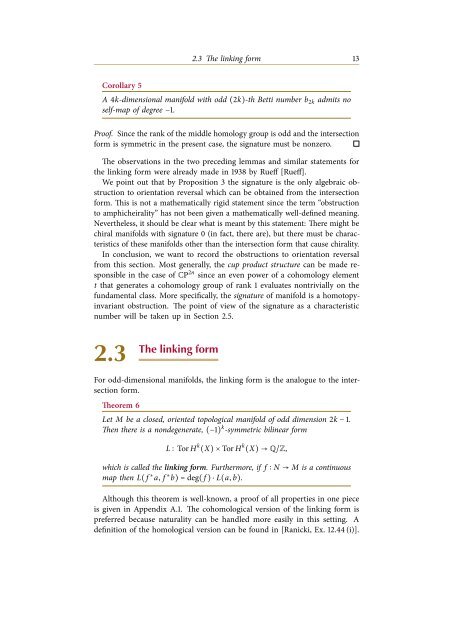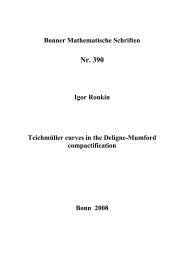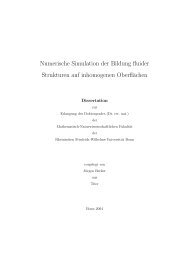Orientation reversal of manifolds - Universität Bonn
Orientation reversal of manifolds - Universität Bonn
Orientation reversal of manifolds - Universität Bonn
You also want an ePaper? Increase the reach of your titles
YUMPU automatically turns print PDFs into web optimized ePapers that Google loves.
2.3 The linking form 13<br />
Corollary 5<br />
A 4k-dimensional manifold with odd (2k)-th Betti number b 2k admits no<br />
self-map <strong>of</strong> degree −1.<br />
Pro<strong>of</strong>. Since the rank <strong>of</strong> the middle homology group is odd and the intersection<br />
form is symmetric in the present case, the signature must be nonzero.<br />
The observations in the two preceding lemmas and similar statements for<br />
the linking form were already made in 1938 by Rueff [Rueff].<br />
We point out that by Proposition 3 the signature is the only algebraic obstruction<br />
to orientation <strong>reversal</strong> which can be obtained from the intersection<br />
form. This is not a mathematically rigid statement since the term “obstruction<br />
to amphicheirality” has not been given a mathematically well-defined meaning.<br />
Nevertheless, it should be clear what is meant by this statement: There might be<br />
chiral <strong>manifolds</strong> with signature 0 (in fact, there are), but there must be characteristics<br />
<strong>of</strong> these <strong>manifolds</strong> other than the intersection form that cause chirality.<br />
In conclusion, we want to record the obstructions to orientation <strong>reversal</strong><br />
from this section. Most generally, the cup product structure can be made responsible<br />
in the case <strong>of</strong> CP 2n since an even power <strong>of</strong> a cohomology element<br />
t that generates a cohomology group <strong>of</strong> rank 1 evaluates nontrivially on the<br />
fundamental class. More specifically, the signature <strong>of</strong> manifold is a homotopyinvariant<br />
obstruction. The point <strong>of</strong> view <strong>of</strong> the signature as a characteristic<br />
number will be taken up in Section 2.5.<br />
2.3<br />
The linking form<br />
For odd-dimensional <strong>manifolds</strong>, the linking form is the analogue to the intersection<br />
form.<br />
Theorem 6<br />
Let M be a closed, oriented topological manifold <strong>of</strong> odd dimension 2k − 1.<br />
Then there is a nondegenerate, (−1) k -symmetric bilinear form<br />
L ∶ Tor H k (X) × Tor H k (X) → Q/Z,<br />
which is called the linking form. Furthermore, if f ∶ N → M is a continuous<br />
map then L( f ∗ a, f ∗ b) = deg( f ) ⋅ L(a, b).<br />
Although this theorem is well-known, a pro<strong>of</strong> <strong>of</strong> all properties in one piece<br />
is given in Appendix A.1. The cohomological version <strong>of</strong> the linking form is<br />
preferred because naturality can be handled more easily in this setting. A<br />
definition <strong>of</strong> the homological version can be found in [Ranicki, Ex. 12.44 (i)].





